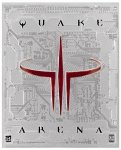8th November 2000, 01:36 pm
I’ve just bought 128 MB of RAM extra for my machine. That brings the total
amount of RAM up to 256 MB. If you count the 64 MB on my
V7700, then
the total is 320 MB :-)
So now I’ve finally got rid of the swap-file. Nice. I can now play
Quake and have a bunch of
Eterms and Emacs open at
the same time.
8th November 2000, 11:21 am
 You bet!
You bet!
I’ve just bought the Linux-version of
Quake from a Danish reseller of
Lokigames, called
linuxspil.dk. And it plays beautifully :-)
With my new
V7700
GeForce2 Ultra
graphicscard from Asus, I can play the game at a
resolution of 1600×1200 under Linux (just as I can under Windows). I think it’s
nice to see, that the hardware manufactures are finally providing desent drivers
for Linux.
3rd November 2000, 09:37 pm
Yesterday I stumbled across something called Domino Day 2000. It turned out
to be an attempt to break the world-record in making a chain-reaction. Over
3 million domino bricks tumblet over — it took about 100 minutes.
70 students had been working for 7 weeks to make it possible, and then it’s
all over in just one and a half hour :-) It was quite funny to watch,
though.
24th October 2000, 05:46 pm
I know that I haven’t been updating this page so often lately, but I’ve
been busy with other things. One of those things is my new menu-system.
The main requirement for the new system was, that it should be able to deal
with a tree of pages several levels deep. The new system handles this
beautifully, as you can see at the sitemap. Notice how the lists are nested
within each other. The most extreme case is at the bottom, where I use five
levels to describe the structure of my Danish Stuff.
To define this structure, I have all the pages specify their parent and
their children. All pages have a parent, but does not necessarily have any
children. I store all this information in a huge array, which means that it
is extremely easy to access the information.
Because all the pages have a reference directly to their parent, it’s quite
easy to find your way back to the root of the tree. All you have to do, is
to use a recursive function. This function takes one argument: the node
who’s parent we want to find. So the function just adds the node to a
global array, and then it calls itself with the parent as an argument.
This means that you’ll eventually reach the root, where the parent will be
an empty string (''). It’s called recursion because we have a function
that keeps executing itself until some condition has been met. Because I
can now use recursion, the code needed to build the sitemap, has
been cut in half.
The next task, is to make some tools to make it easier for me (and
eventually also others) to maintain the structure. I’ll let you know when
it’s ready.
16th October 2000, 03:52 pm
I’ve started to rewrite my menu-system here at gimpster.com. The current
system only works when the tree-structure is two levels deep. You can see
this on my sitemap.
The new system will be able to handle an arbitrary number of levels
(remember, though, that a PHP script can only use 8 MB of RAM :-).
In the new system, all pages have a parent, and perhaps also some children.
This is what connects the different pages too one another, it defines a
tree of so-called double-linked lists. The lists are double-linked because
each node defines both the next and the previous node in the tree. This
makes it very easy to find out who the parent is to a particular node. And
to find other nodes at the same level as the current node, you just look up
the parent. Now that you know the parent, you can easily find the children
of the parent.
Thanks to the very flexible way PHP handles arrays, I can store all the
information in a huge multidimensional array. That makes it very easy to
access the information.
 You bet!
You bet!